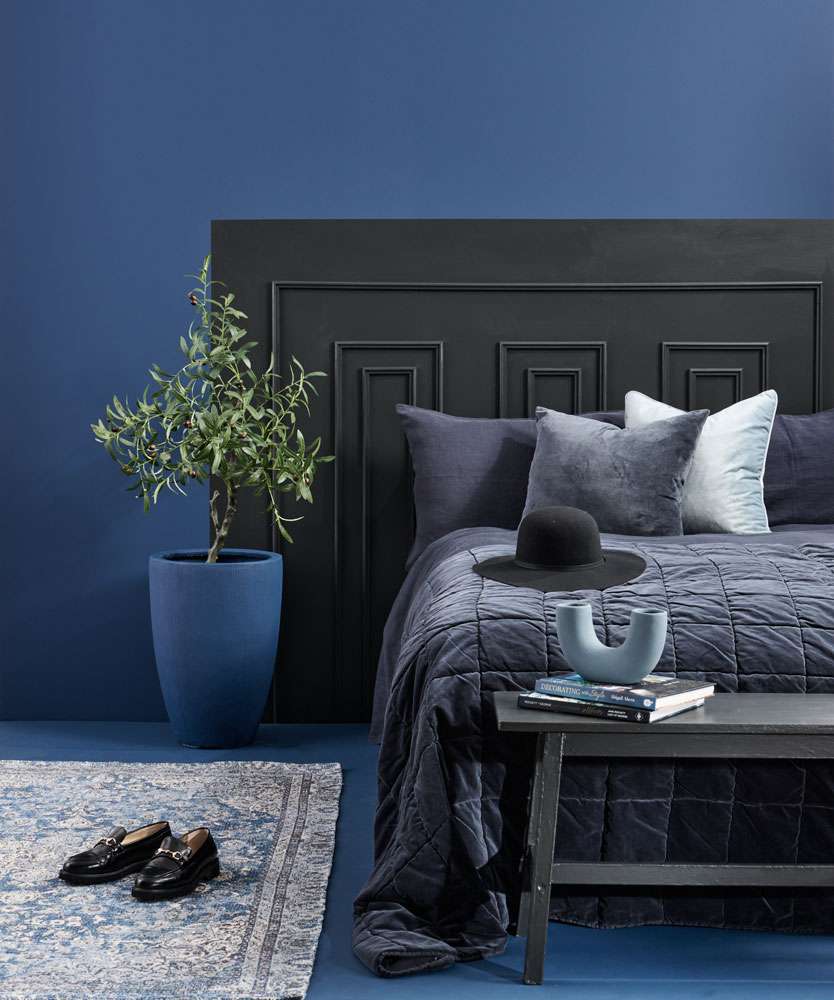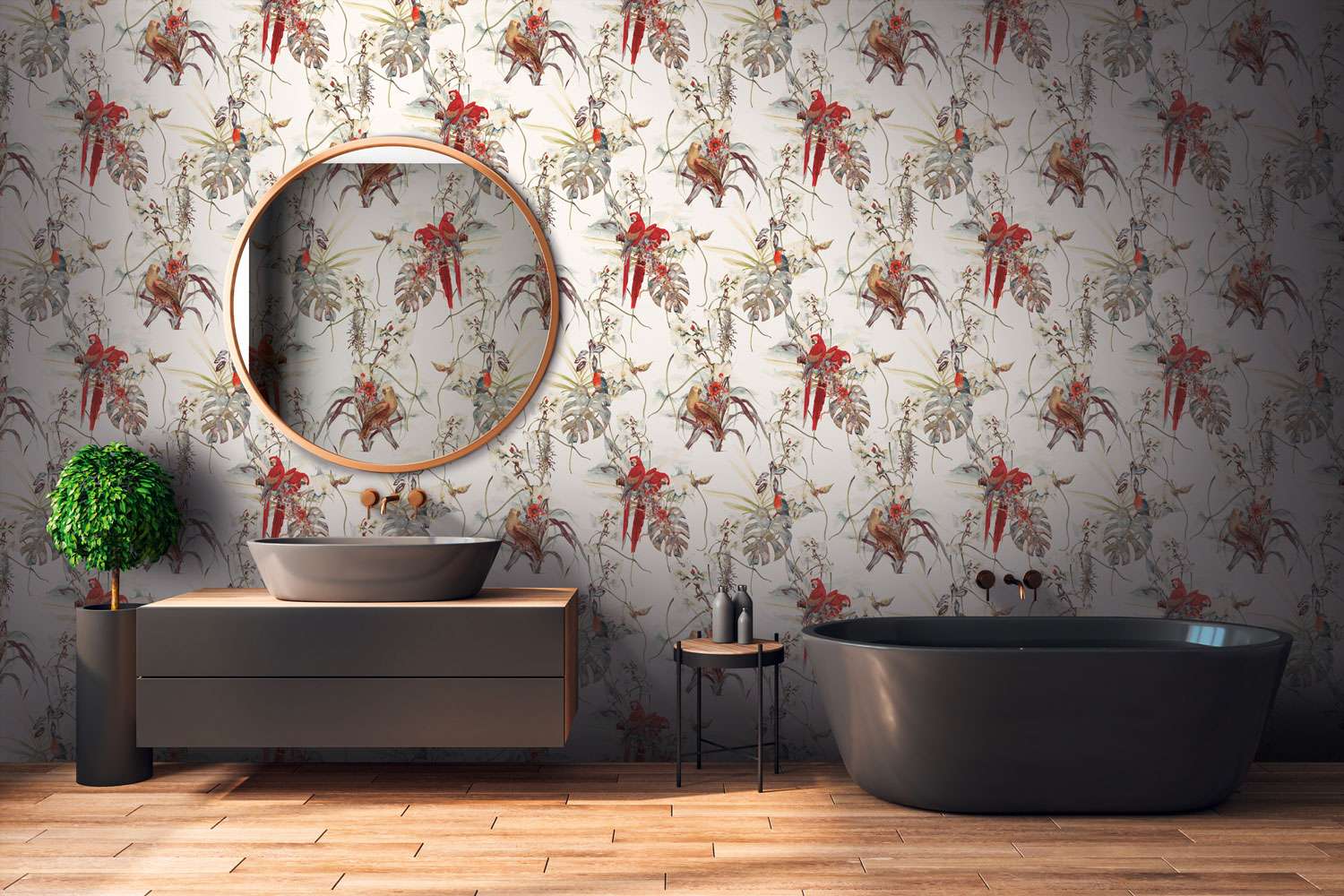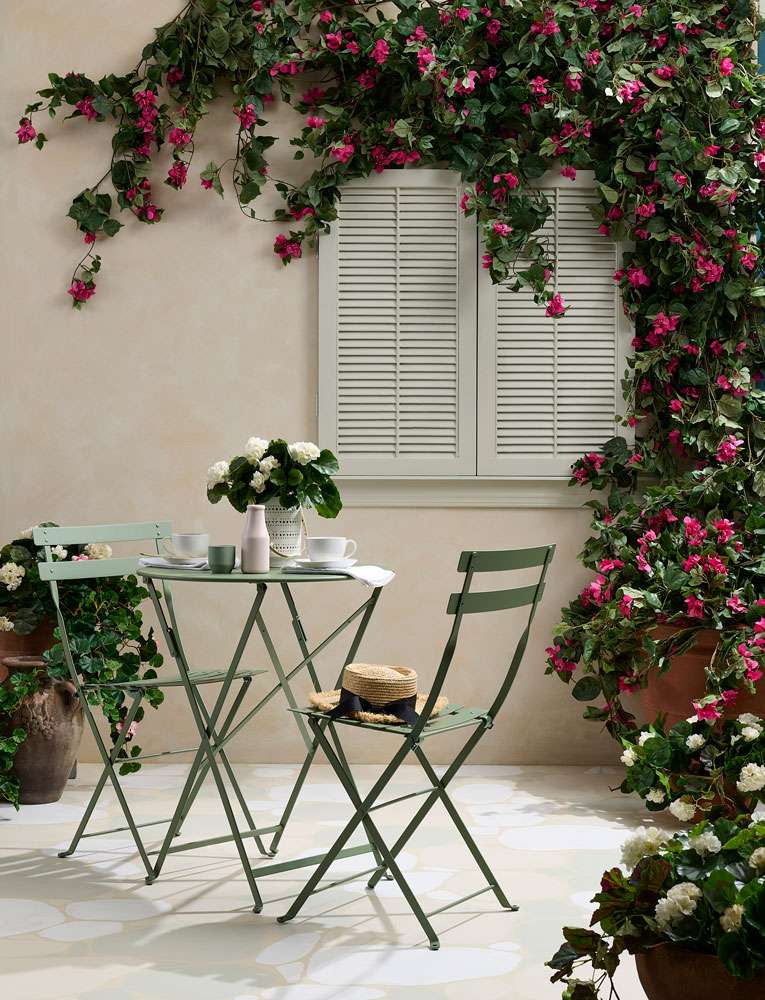Keep your house in tip-top condition while tackling that mould and mildew.
The winter months can be an excellent time to catch up on maintenance projects inside and outside your house.
With cooler, wetter weather we often spend more time at home which makes it easier to keep an eye on any area that might need maintenance and to chip away at those jobs when you have time, rather than being faced with a huge maintenance effort come spring.
Wetter, cooler weather can also cause new problems to surface like mildew. Keeping an eye on susceptible areas through winter can help you catch problems early and get on top of them before a major repair or maintenance job is needed.
Start your property search

When cleaning your walls, feather out the edges of the cleaned area to help them blend into the surrounding area. Wall and floor painted in Resene Ocean Waves, headboard in Resene Element, large planter in Resene Ocean Waves, bench seat in Resene Watermark and U-shaped vase in Resene Eau De Nil. Bed linen from Citta, rug from Bed Bath and Beyond, shoes from Miss Wilson. Project by Melle Van Sambeek, image by Bryce Carleton.
Check for mould and mildew
There are obvious places to keep an eye out for mould and mildew such as wet zones, like bathrooms and laundries, or outdoor areas on the south or less sunny parts of your property. However, other less obvious areas, particularly those with little to no airflow, can also be prone to mould and mildew.
Every house will be different but some areas to check include behind couches and around doors and window frames. You should also check for any areas of peeling wallpaper and carpet areas near doors or potential sources of moisture.
Top tip: On painted surfaces mould looks like dirt and often it can be difficult to distinguish between the two just by looking, says Ashleigh Strange from the Resene advice team. The most common mould species are black, but others may be brown or green. By wetting the surface and rubbing, mould will show up as slime.
If you find mould or mildew, give the area a good clean with Resene Moss & Mould Killer, says Ashleigh, which should not only rid it of mould but prevent it from returning.
“A lot of mould spores are invisible to the naked eye so wiping away is not treating the mould. It does need to be killed,” she says.
Resene Moss & Mould Killer is designed to treat the problem and then be washed off, making it a great choice if you are repainting the surface. It’s also great on concrete driveways, walls or patios, which can be prone to slippery moss and mould if they don’t see a lot of sun over winter.
If you want to clean but not repaint yet, you can clean with Resene Interior Paintwork Cleaner or, for outdoor areas, Resene Deep Clean which is left on and works with UV light and rain over time for a thorough clean.
Of course, if you do find mould or mildew in less expected areas try to find the source of the moisture so it can be fixed and any further damage avoided. For example, Ashleigh suggests checking interior windows and frames for excess condensation and moisture running down the glass ponding on windowsills.
“This will aid in mould growth and damage the surface of your paint over time. Where possible ventilate and remove excess moisture,” she says.

Wallpapers marked scrubbable or washable can be easily, gently cleaned with soap and water. Walls finished in Resene Wallpaper Collection 38725-1, which pairs well with painted surfaces in Resene Domino or Resene Tobacco Brown, and flooring stained in Resene Colorwood Natural.
Wallpaper cleaning and care
Repairing a mould issue on wallpapered walls can be a bigger problem to fix, which is a great reason to have checking your walls on your regular maintenance checklist, particularly after long periods of damp, wet weather.
If you see dark spots, normally near the ceiling on your wallpaper, wipe the paper down according to the instructions for your wallpaper; some are washable or scrubbable, others should only be cleaned gently with a dry sponge. If the dark spots come away without staining the paper, the problem is likely to be just a lack of ventilation in the room.
However, if your wallpaper is lifting in some areas and both it and the wall underneath are stained, it could mean there is moisture trapped under the wallpaper. This generally means the wallpaper needs to be removed and the wall washed down with an anti-mould solution such as Resene Moss & Mould Killer. When dry, seal the walls with a pigmented sealer to seal in any remaining mould spores. Sand when dry, dust off then re-wallpaper.
Top tip: Cleaning with an anti-mould solution as part of your preparation before you start redecorating a room, whether it is with paint or wallpaper, will help keep your new finish in good condition. Mould left untreated can grow through your new finish.
If you’re just giving your wallpaper a clean, rather than fixing mould issues, simply wash with warm water, soap and either a soft sponge (washable wallpapers), a soft brush (scrubbable papers) or a dry sponge (delicate papers).
Don’t use abrasive cleaners or scrubbers like steel wool, or any type of bleach. Rinse once you have finished cleaning and be careful not to over wet the surface. Blot dry with a lint-free cloth.
If you have a difficult dirt spot that isn’t shifting, use a stronger detergent but test it on a small inconspicuous spot first before using it on the whole wall.
Top tip: Wash from the bottom of the paper up to avoid dirty water running down the face of the wallpaper (or painted walls).

Using Resene Moss & Mould killer at the preparation stage before painting will help keep your fresh paintwork looking good. Wall painted in Resene Half Canterbury Clay with Resene FX Paint Effects Medium mixed with Resene Eighth Canterbury Clay and Resene Double Spanish White. Shutters and windowsill painted in Resene Kangaroo and patio floor painted with faux cobbles in Resene Half Canterbury Clay, Resene Eighth Canterbury Clay, Resene Double Spanish White, Resene Blanc, Resene Paris White and Resene Half Spanish White. Table and chairs from Jardin. Project by Annick Larkin, image by Bryce Carleton.
Outdoor clean up
Washing the exterior of your house once a year is a good way to help protect the life of your paint, Ashleigh says. Not only does it help prevent the build-up of moss, lichen and mould but it also removes other damaging deposits like salt.
For an instant fresh appearance, regularly wash down your home with Resene Paint Prep and Housewash diluted as recommended with water. Apply the diluted solution with a soft broom. Wash off with lots of fresh water.
For a slower-acting, longer-term clean, use Resene Deep Clean which is designed to break down surface contamination over time.
If you are wanting to give a newly-painted house exterior a clean, make sure you wait at least four weeks after painting to ensure the topcoat is fully cured.
Finally, don’t be tempted to clean wooden weatherboards - or decking and wood furniture - by water blasting. The pressure can force water up under weatherboards or damage the wood surface. Keep your water blasting for harder surfaces like concrete, and remember, while water blasting can be useful for removing visible mould from those surfaces it won’t kill it and prevent it from returning.
Top tip: Most detergents can have a negative effect on fish life so avoid letting the washings run off into the stormwater system.
Attend to areas of flaking paint, stained paint (treat the source of the stain, then touch-up the paint finish as required), moss and mould and rotten areas of timber.
If you have outdoor seating, tables or even a BBQ bench, planters or a shed, give them all a once-over. Check for areas that might need repairs to make them safe to use.
Give them a wash down, to remove flaking paint and any moss, mould or mildew.
If some of your furniture is looking a bit tired, a fresh coat of paint or, for wooden furniture, stain is a cost-effective and quick way to bring it back to life - and maybe get a season or two more from it before it needs replacing.
If you’re staining wooden furniture and planters, experiment with different shades instead of just the natural wood colour. Darker stains like Resene Woodsman Treehouse or Resene Woodsman Banjul look dramatic and modern with bright-coloured cushions and throws. Using a darker shade on planters and fences also makes them recede so the focus is on your beautiful flowers, vegetables and shrubs. If you’re choosing a dark colour, consider using a Resene CoolColour version of your colour to reflect more heat.

Avoid water blasting to clean weatherboards and wooden decks or furniture. It won’t kill mould and can damage the surface. These wooden weatherboards are painted in Resene Baring Head, with the deck stained in Resene Woodsman Uluru. The light fitting is Resene Alabaster. Artwork surround in Resene Alabaster and Resene Timeless with round frame and small vase in Resene Ocean Waves. Chairs, table and clam shell from Danske Møbler, cushions from Bed Bath and Beyond, tableware from Good Thing. Project by Melle Van Sambeek, image by Bryce Carleton.
Other maintenance areas to check:
1. Fingerprints around light switches and high contact areas should be cleaned frequently to avoid oily build-up from hands. Try Resene Interior Paintwork Cleaner.
2. Check windows and exterior doors for sticking. Sometimes excessive wet weather can cause wood frames to swell, causing windows and exterior doors to stick. Be wary of sanding back surfaces for a better fit, as the timber can shrink again in warmer, drier conditions, leaving you with a gap. Instead, just make sure hinges and frames are clean and free of debris. If windows or doors have been shut after painting before the topcoat is completely dry, a gentle sand back may help. Then repaint with your topcoat and leave to thoroughly dry before shutting the window. Once completely dry you could try spraying the surface with a light layer (wipe off any excess) of furniture polish to keep things moving freely.
3. Check the roof for mould, lichen and leaks. It’s easy to forget about your roof, but whether it’s painted steel or tile, checking the surface once a year is essential to making sure it lasts a long time. Give painted roofs a wash with Resene Roof and Metal Wash. Replace any nails that may have rusted or worked loose on older roofs, check any joins, such as where a flue enters the roof for signs of leaks, and flashings. If you find patches of bare iron where paint has weathered and flaked, clean and sand the area then apply a primer such as Resene Summit Roof, or Resene Galvo One.
4. Clean away any solids sitting directly against the exterior cladding as it will trap moisture causing mould and rot.
For advice on the best way to clean and maintain your home, visit your local Resene ColorShop, ask a Resene Paint Expert online, www.resene.com/paintexpert or book a Resene Colour Consultation, www.resene.com/colourconsult.











